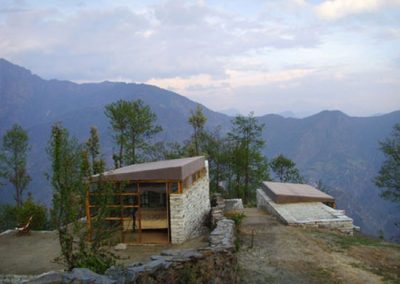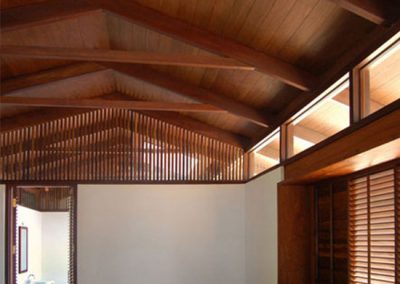Bijoy Jain
India Arch Dialogue 2016


Founded by Bijoy Jain, Studio Mumbai works with a human infrastructure of skilled artisans, technicians and draftsmen who design and build the work directly. This group shares an environment created from an iterative process, where ideas are explored through the production of large-scale mock-ups, models, ma- terial studies, sketches and drawings. Projects are developed through careful consideration of place and practice that draws from traditional skills, local building techniques, materials and an ingenuity arising from limited resources.
Bijoy Jain was born in Mumbai, India in 1965 and received his M. Arch from Washington University in St Louis, USA in 1990. He worked in Los Angeles and London between 1989 and 1995 and returned to India in 1995 to found his practice.
The work of Studio Mumbai has been presented at the XII Venice Biennale and the Victoria & Albert Mu- seum, and received several awards, including the Global Award in Sustainable Architecture (2009) finalist for the 11th cycle of the Aga Khan Award for Architecture (2010), winner of the seventh Spirit of Nature Wood Architecture Award, Finland (2012), winner of the third BSI Swiss Architecture Award (2012), most recently winner of the Grande Medaille d’Or from the Academie D’Architecture, Paris, France (2014), and the University of Hasselt, Belgium bestowed an honorary doctorate on Bijoy Jain in 2014. He has taught in Copenhagen (2012), fall semester at Yale (2013), spring semester in Mendrisio (2014) and will be teaching the spring semester in Mendrisio in 2015 as well.
TEACHING
- 2012 The Royal Danish Academy of Fine Arts School of Architecture, Design & Conservation – School of Architecture, Copenhagen, Denmark
- 2013 Yale University, New Haven, USA
- 2014 USI, Mendrisio, Switzerland – The Academy of Architecture
- 2015 USI, Mendrisio, Switzerland – The Academy of Architecture
KEY PROJECTS
- 2003 Reading Room, Nagaon, Maharashtra, India
- 2003 Kapadia House, Satirje, Maharashtra, India
- 2006 Bungalow 8, Mumbai, Maharashtra, India
- 2007 Palmyra House, Nandgaon, Maharashtra, India
- 2007 Leti 360 Resort, Leti, Uttaranchal, India
- 2005 Tara House, Kashid, Maharashtra, India
- 2008 House on Pali Hill, Bandra, Mumbai, India
- 2008 Utsav House, Satirje, Maharashtra, India
- 2008 Belavali House, Belavali, Maharashtra, India
- 2010 Copper House II, Chondi, Maharashtra, India
- 2010 In-Between Architecture, Victoria & Albert Museum, London, United Kingdom
- 2010 Work-Place, Venice Biennale 2010, Venice, Italy
- 2011 House on Kankeshwar Hill, Kathalpada, Maharashtra, India
- 2011 Meta Chile, Concepción, Chile
- 2012 Two Office Towers, Zhengzhou, China
- 2012 Residential Tower, Mumbai, Maharashtra, India
- 2014 Carrimjee House, Katalpada, Maharashtra, India
- 2014 Saat Rasta houses, Mumbai, Maharashtra, India
- 2014 Ahmedabad Residence, Ahmedabad, Gujirat, India
ON-GOING PROJECTS
- Ganga Maki Textile Studio, Dehradun, Uttarakhand, India
- Banga house, Nagaon, Maharashtra, India
- Kasauli houses, Kasauli, Himachal Pradesh, India
- Onomichi community center, Onomichi, Japan
- Chennai House, Chennai, Tamil Nadu, India
- Sunita Namjoshi house, Nagaon, Maharashtra, India
- Solo houses, Barcelona, Spain
- Erlenbach houses, Zurich, Switzerland
- Mahindra house, Nagaon, Maharashtra, India
- Hotel du Couvent de la Visitation, Nice, France
- Bridge by the canal, Bruges, Belgium
- Hotel Ganges View, Varanassi, Uttar Pradesh, India
AWARDS
- 2014:Winner of Grande Medaille d’Or, Academie D’Architecture, Paris, France
- 2012:Winner of the third BSI Swiss Architectural Award, Lugano, Switzerland
- 2012:Winner of the seventh Spirit of Nature Wood Architecture Award, Lahti, Finland
- 2010:Special Mention for Installation -Work-Place, 12th International Architecture Exhibition, Venice Bien- nale
- 2010:Finalist for the 11th cycle of Aga Khan Award for Architecture
- 2009:Global Award for Sustainable Architecture from the Institut Français de Architecture
- 2009:Merit Recognition in Design – Palmyra House Design for Asia Award from Hong Kong Design Cen- tre
- 2008:Award for Emerging Architects (Commended): Palmyra House Architectural Review
- 2007:Design Excellency Award – Leti 360 Design for Asia Award from Hong Kong Design Centre
EXHIBITIONS
- 2015 Bruges Triennale – Bridge by the canal, Bruges, Belgium
- 2014 “In between the sun and the moon” Arc-en-Reves, Bordeaux, France
- 2014 Kochi-Muziris Biennale 2014, Kochi, Karnataka, India
- 2014 Rooms You May Have Missed, Canadian Center for Architecture, Montreal, Canada
- 2013 Architecture as an Open Process; Delhi, Ahmedabad and Mumbai, India
- 2013 Demolition Series, Chemould Gallery, Mumbai, India
- 2013 Immediate Shelters, Sharjah Biennial 11, Sharjah Art Foundation, Sharjah, UAE
- 2012 Praxis, British School at Rome, Italy
- 2012 Praxis, TOTO Gallery MA, Tokyo, Japan
- 2012 MOMAT Pavilion, The National Museum of Modern Art, Tokyo, Japan
- 2012 The Altar Wunderkammer experiment: Conducted by Tod Williams and Billie Tsien, 13th Internation- al Architecture Exhibition, Venice Biennale, Italy
- 2011 Studies, Indian Highway IV, Lyon Museum of Contemporary Art, Lyon, France
- 2011 Work-Place, Archizoom and the Ecole Polytechnique Federale de Lausanne, Lausanne, Switzerland
- 2010 Work-Place, People Meet in Architecture12th International Architecture Exhibition, Venice Biennale.
- 2010 In-between Architecture, Victoria & Albert Museum, London, UK, 1:1 Architects Build Small Spaces
- 2010 Selected Works, Learning from Vernacular, Association pour un Centre Architecture Anthropologie Territoire (ACAAT) in collaboration with the Vitra Design Museum, at Rossiniere, Switzerland
- 2010 Copper House II GA Houses Project
- 2008 Selected Works, High-Tech and Tradition, Tokyo Design Center, Japan
ABOUT MODEL
Exhibiting: Model Name : Tazia
Tazias are miniature cenotaphs made to be carried on shoulders in remembrance of an Islamic saint. These structures are made entirely of bamboo sticks, cotton strings and river- mud. Finally, they are clad in ‘carved’ paper so as to imitate the intricate stone carvings of tomb-architecture. Strings are simply wrapped around bamboo joints and just held by mud instead of being tied. This fragility of construction allows the Tazias to dissolve and disintegrate in water at the end of rituals.
Every little detailing – from imagining the design, making the structure, carving the paper, embellishing – right up to lighting it up is all done by intense participation of an extended family or the neighbourhood. Everyone plays a role in the making of a Tazia. This oneness with the object brings a certain frugality and finesse in these temporal structures. While faith is the driving force behind those constructions, the lucidity of the outcome reveals an innate yet humble architectural understanding of the people
IAD 2016 Participating Architects
Supported by





































